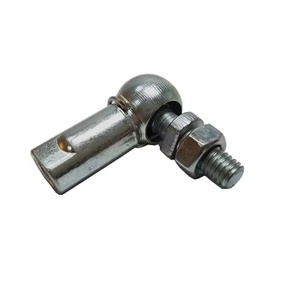One end of it is a threaded screw used for threaded connections with other components; The other end is in the shape of a ball head. This design has some significant advantages. The ball head can provide certain angle adjustment and range of motion, increasing the flexibility of the connection. For example, in the suspension system of a car, the use of threaded bolt ball heads can adapt to various dynamic changes during vehicle operation, reduce rigid impacts between components, and improve the performance and comfort of the suspension system.
In the field of mechanical manufacturing, threaded screw ball heads are commonly used in situations that require flexible connections and can withstand certain loads. For example, the joint connections of some automation equipment can make the movement of the equipment smoother and more stable.
In addition, it may also be used in furniture manufacturing, such as adjustable table and chair component connections, which facilitate users to adjust angles and heights according to their own needs.
Different application scenarios may have different requirements for the material, size, strength, etc. of threaded screw ball heads. Common materials include stainless steel, carbon steel, etc. The size depends on the specific connection requirements, and the strength needs to be selected according to the appropriate specifications based on the load it bears.
When installing and using threaded screw ball joints, ensure that the threaded connection is tight, the ball joint moves freely, and there is no jamming phenomenon. At the same time, it is necessary to regularly check for wear, looseness, and other conditions to ensure the reliability and safety of the connection.
Ball joints have multiple functions in mechanical design. The following are its main functions:
Free motion and motion constraints: The design of ball joints allows connectors to move freely in multiple directions while also limiting their motion in other directions. This constraint method enables the connector to move flexibly within a specific range, thereby achieving various complex functions.
Simple, reliable, and durable: Ball Joints have the advantages of simple structure, high reliability, and long service life. This enables it to play a stable and reliable role in various mechanical systems.
Widely used: The application of ball joints in mechanical devices is mainly reflected in the motion constraints of connectors. For example, in the joint part of a robot, spherical hinges can achieve flexible motion constraints, allowing the robot to move freely in various directions. In addition, Ball Joints are also commonly used in automotive suspension systems, aerospace fields, and industrial machinery equipment.
Improving transmission efficiency: The design of ball joints can reduce friction losses, improve transmission efficiency, and ensure the stability and accuracy of mechanical equipment movement. This enables mechanical equipment to operate more efficiently, reducing energy consumption and failure rates.
Ball joints play an important role in mechanical design, enabling free movement and constraint of connectors in multiple directions. They also have advantages such as simple structure, high reliability, and long service life, and are widely used in various mechanical systems.
